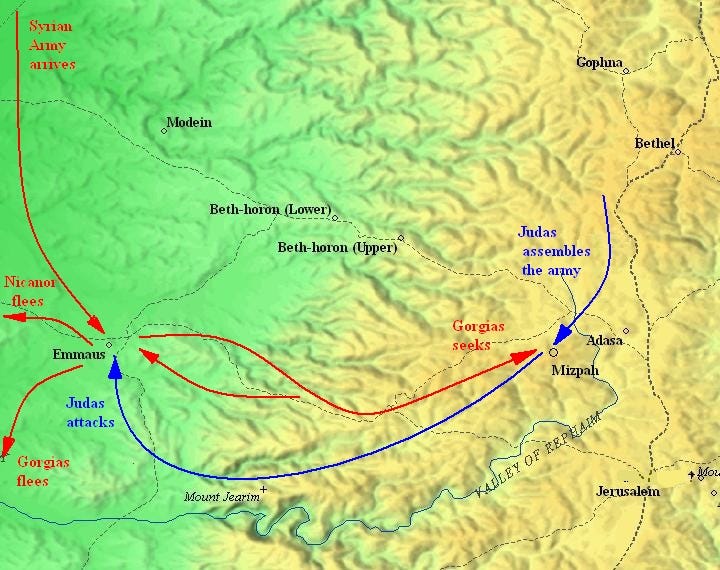The Emmaus Road
“Were not our hearts burning within us while he talked with us on the road and opened the Scriptures to us?”
Given the history and drama of the Jerusalem/Jericho passage, the Emmaus Road could seem a bit of a disappointment, mainly due to the uncertainty as to the exact location of the village of Emmaus.
We do know that it was close to Jerusalem and current archaeological wisdom corresponds with the Lucan Gospel that places it about 7.5 miles west northwest from the holy city. Not only was this road shorter than the Jerusalem/Jericho Road, the topography did not present as many physical challenges. In fact, by the standards of the day, it was relatively flat.
However, there was a significant moment that was evocative enough that Luke ended his Gospel with it, when two pilgrims returning from Passover in Jerusalem find themselves with a remarkable travel companion.
Now on that same day two of them were going to a village called Emmaus, about seven miles from Jerusalem, and talking with each other about all these things that had happened. While they were talking and discussing, Jesus himself came near and went with them, but their eyes were kept from recognizing him. And he said to them, “What are you discussing with each other while you walk along?” They stood still, looking sad. Then one of them, whose name was Cleopas, answered him, “Are you the only stranger in Jerusalem who does not know the things that have taken place there in these days?” He asked them, “What things?” They replied, “The things about Jesus of Nazareth, who was a prophet mighty in deed and word before God and all the people, and how our chief priests and leaders handed him over to be condemned to death and crucified him. But we had hoped that he was the one to redeem Israel. Yes, and besides all this, it is now the third day since these things took place. Moreover, some women of our group astounded us. They were at the tomb early this morning, and when they did not find his body there they came back and told us that they had indeed seen a vision of angels who said that he was alive. Some of those who were with us went to the tomb and found it just as the women had said, but they did not see him.” Then he said to them, “Oh, how foolish you are and how slow of heart to believe all that the prophets have declared! Was it not necessary that the Messiah should suffer these things and then enter into his glory?” Then beginning with Moses and all the prophets, he interpreted to them the things about himself in all the scriptures.
As they came near the village to which they were going, he walked ahead as if he were going on. But they urged him strongly, saying, “Stay with us, because it is almost evening and the day is now nearly over.” So he went in to stay with them. When he was at the table with them, he took bread, blessed and broke it, and gave it to them. Then their eyes were opened, and they recognized him, and he vanished from their sight. They said to each other, “Were not our hearts burning within us while he was talking to us on the road, while he was opening the scriptures to us?”
That has always been a powerful and touching question.
Despite its mysterious location, or perhaps because of it, to travel on the Emmaus Road has become a metaphor for a gradual sense of revelation.
But there is another event in the First and Second Books of the Maccabees, found in the collection of “intertestamental” scripture known as the Apocrypha, that is useful in understanding the important context of Emmaus in later 1st century A.D. Jerusalem.1
The two Books of the Maccabees cover the transitional period in the 2nd century B.C. when the Jews rebelled against the Greco-Syrian rulers of the Seleucid Empire and re-established themselves, at least temporarily, as an independent kingdom.
The historic Revolt of the Maccabees, so named after its leader, Judas Maccabeus [which means “The Hammer”], continued to claim the imagination of Jews over a century later and under-girds the expectation that the Messiah would be a military leader who would overthrow the Romans in the same manner as The Hammer and his followers overthrew the Greco-Syrians and reclaimed The Temple.2
A seminal event in the revolt was the Battle of Emmaus.3 Judas Maccabeus and his followers would use their knowledge of the Emmaen roadway and terrain to overrun an enemy camp and help themselves to a moral victory and some much needed weaponry, turning the tide of war in the Jews’ favor.
The battle would have been part of the cultural memory of Luke’s two pilgrims as they made their way down the Emmaus Road, thinking of what they had just witnessed in Jerusalem. Their walk presents a poignant dichotomy in that they now trek through the setting of an ancient battle with a companion who teaches them of a more complete and eternal victory.
No wonder their hearts were burning.
For those who may not be familiar with the Books of the Maccabees, but believe you have heard a reference somewhere before, we conclude today with a familiar portion of Handel’s Judas Maccabaeus oratorio.
The Episcopal Church, along with the rest of The Anglican Communion, includes Apocryphal literature as an option in its lections. Also of note, we read of the creation of the tradition of Hanukkah in I Maccabees 4:36-59
This was a particularly important reclamation as Antiochus Epiphanes, the Seleucid ruler, had been using The Temple in Jerusalem as a site of ritual pig sacrifice!
1 Maccabees 3:38–4:25 and 2 Maccabees 8:8–36.




